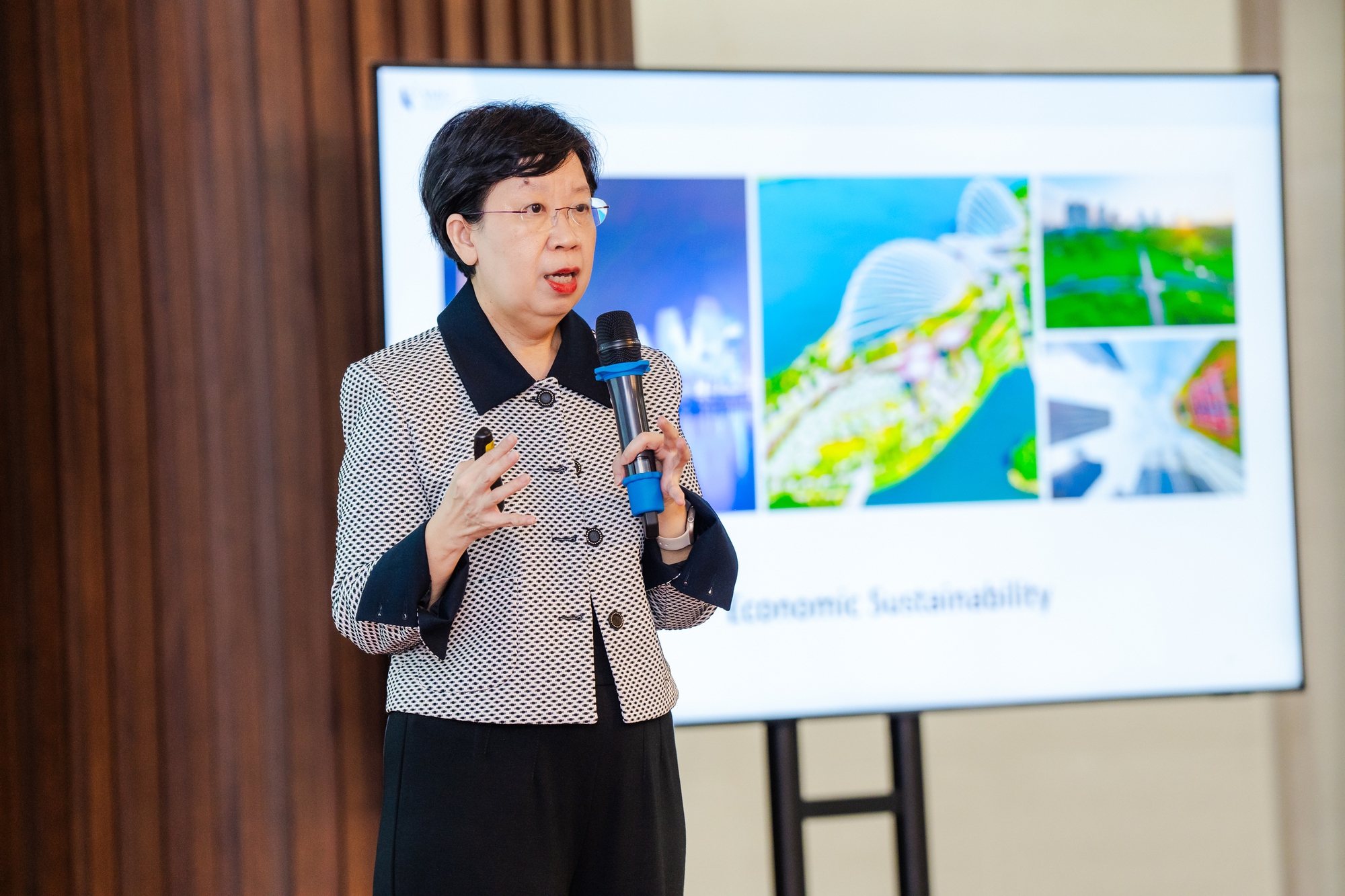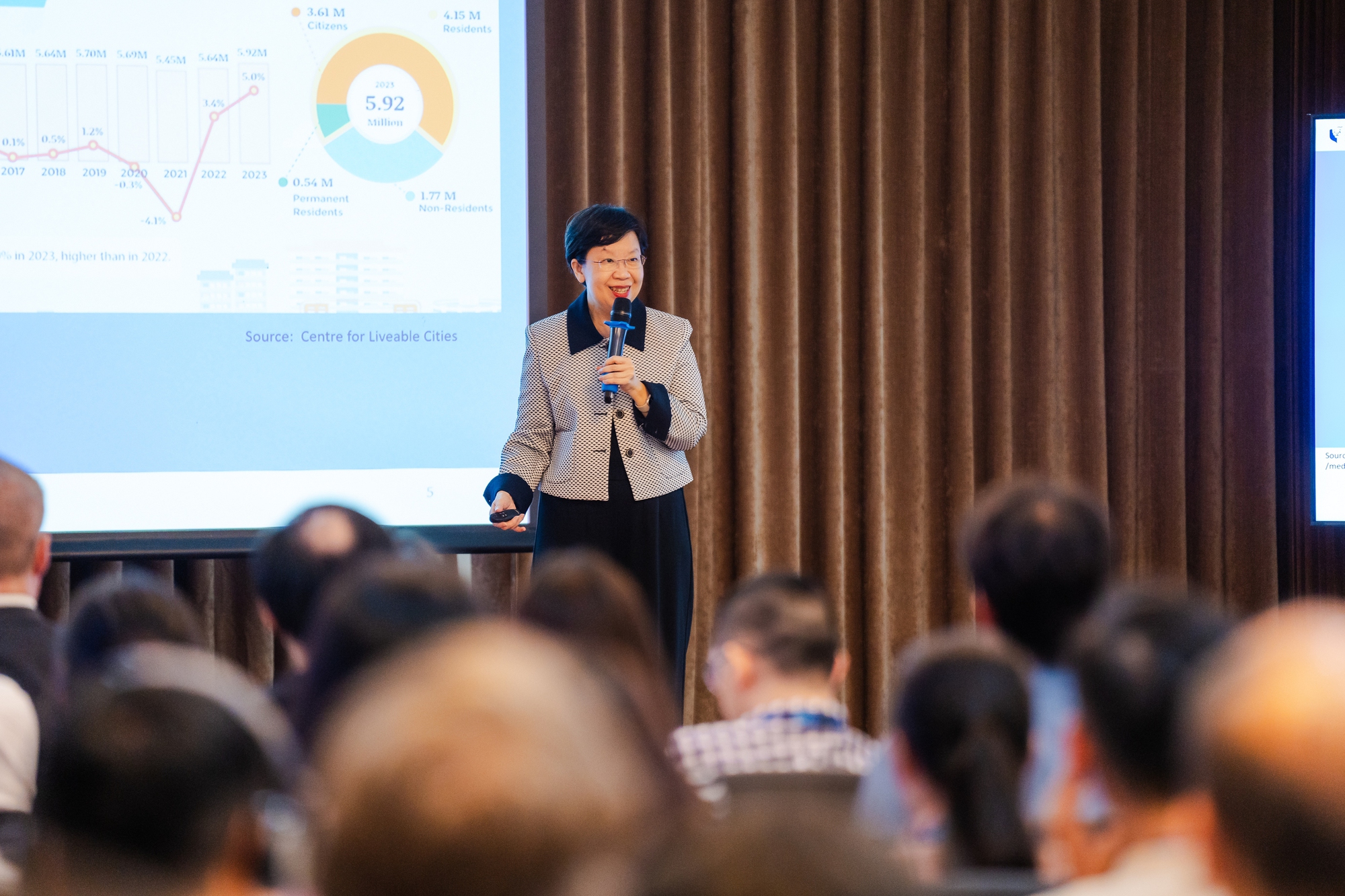The adoption of green growth is widely seen as an imperative for a sustainable future and has been a key goal for Vietnam in recent years and moving forward. This encompasses green growth in combination with the tight and harmonious integration of socio-economic development with environmental protection.
Accordingly, people will be the central focus and the main decision-makers for living green and moving to renewable energy with the goal of reaching net zero greenhouse gas emissions.
So how should Vietnam get started with green transition for sustainable development?
On the occasion of SMU leaders visiting Vietnam, PV recently had a conversation with Professor Lily Kong, President of SMU, one of the leading experts and contributors to green growth in Singapore.
“I was really amazed by the development of Hanoi”

Professor Lily Kong is the current President of Singapore Management University (SMU).
Have you ever been to Vietnam, Professor? What is your initial assessment of Vietnam’s development?
Professor Lily Kong: Oh, I have been to Vietnam 4 or 5 times. I have been to Hanoi and Ho Chi Minh City. The last time I came to Vietnam was just before COVID-19 happened. At that time, I visited the Old Quarter in Hanoi, experienced the cultural characteristics and learned about Vietnam’s historical stories. This time, as soon as I arrived at the airport, I went straight to the Ocean City area. This is probably a very new area in Hanoi.
I was really surprised and amazed by the pace of development and transformation of the city. Because as far as I know, this area used to be rice fields and marshes. But now, there are high-rise buildings with many “vibes” from different cultures. I felt like I was in London (England), Venice (Italy), and Korea… Hanoi now looks very modern and international. I think Hanoi is fully capable of becoming the next Singapore in the near future, or even surpassing it, if it invests heavily in urban planning such as housing, transport, and people.
As an experienced expert in green growth and sustainable development in Singapore, what are the opportunities for Vietnam to develop in this field, in your opinion?
Professor Lily Kong: I find that Vietnam is at a critical stage, a pivotal stage. This is the stage where we start building new metropolises, new residential areas. Therefore, if you really want to be green and sustainable, this is the most opportune time for us to start. When we decide to have a vision, we have to build from there, because it is very difficult to change course in the middle, right? Building and adhering to the set roadmap for green development, sustainable development, we will achieve the desired results.
The opportunities for green growth in Vietnam are very promising. I think the most important thing for Vietnam right now is to identify the most pressing challenges at the moment. If we don’t address them, all other sectors will cease to function. For example, in Singapore, it is the issue of housing. If we don’t have decent housing for our people, nothing else can develop.
One of the important foundations for green growth is having a green transport system. Before that can happen, people need to be “settled”, “to settle down before making a career”. In my opinion, Vietnam can invest in housing, develop green transport, and focus on training high-quality human resources.
Vietnam has many advantages in green development with the active support of the Government, a very strong private sector, and many research institutes and universities. But we need to have cooperation between these three sectors, because each one will bring different values. The combination of these values will create strength and help achieve the effectiveness we desire.

According to Professor Lily Kong, Vietnam has more advantages than Singapore in terms of area, resources, and population…
Professor just mentioned investing in housing and transportation. What difficulties has Singapore encountered in the process of developing social housing and building a transport system?
Professor Lily Kong: As you know, Singapore is a very small country, with a land area of just over 730 km2 and a population of about 6 million. Our country has many constraints from limited natural resources to scarcity of land. We have chosen to develop green and sustainably. In the context of the tension between environmental conservation and economic growth, Singapore has adopted a pragmatic approach that includes stringent regulations, technological innovation and strategic planning.
About 80% of our population lives in public housing. We have a board that takes charge of these housing projects. These are government-led projects and built by businesses specifically for Singaporean citizens. They are rented out at very low prices compared to the market rate.
The housing projects in Singapore are the result of cooperation between the public and private sectors. Therefore, public housing or social housing is a very essential tool in Singaporean society. Because up to 80% of our population currently lives in social housing. It can be said that this type of housing is a place where the majority of Singapore’s population “settles down and makes a career”.
However, besides housing, we also have to build many related policies for the people. For example, housing policies for the young, the elderly, different ethnic groups, which groups will receive a discount… Singapore’s housing policies are enacted to achieve all the goals I just mentioned. That is to ensure housing for the people and at the same time minimize conflicts in the multi-ethnic population, while ensuring the quality of life.
So when we build a city, it’s not just about building houses, bridges, roads, schools, and stations. Instead, when we start building a city, we have to envision what kind of society we want to build. Housing is just the “tool” for us to build the society we want.
Similarly, building a transportation system is the same. I think one of Singapore’s most iconic transportation projects is the Singapore Mass Rapid Transit (SMRT) project. The project started construction in 1982 with a total investment of 5 billion Singapore dollars. By November 1987, the railway system began operating and was officially inaugurated on March 12, 1988 under Prime Minister Lee Kuan Yew. However, it took not only 5 years, we actually spent dozens of years researching transportation, engineering, economics, and finance. Yes, it was a long journey.
To date, this urban rail system spans 200 km, with over 140 stations on six MRT lines across the island, with over three million daily trips.
Have you tried the electric car in Vietnam, Professor? What do you think of the electric car in Vietnam?
Professor Lily Kong: Yes, I have test driven the VinFast car. It runs very well and is very comfortable. Electric vehicles are an inevitable development trend. To promote the use of electric vehicles in Vietnam requires many policies and measures, from making these vehicles affordable to ensuring sufficient charging points and optimizing the location of charging points to ensure acceptable charging time. But solving transportation problems is not just about promoting electric vehicles. It is important to address traffic congestion and road conditions because even the best electric cars will not provide the best experience on bumpy roads.
In addition, we need to provide public transportation that is both convenient and not too expensive. We can move multimodally, that is, not just using taxis, electric motorbikes, electric buses, etc. Instead, we can combine all of those vehicles and ensure that they are seamless, easy to use, and easy to connect.




![[Photo Essay]: Experts, Managers, and Businesses Unite to Forge a Path Towards Sustainable Green Industry](https://xe.today/wp-content/uploads/2025/07/z678592918-150x150.jpg)


![[Photo Essay]: Experts, Managers, and Businesses Unite to Forge a Path Towards Sustainable Green Industry](https://xe.today/wp-content/uploads/2025/07/z678592918-100x70.jpg)




